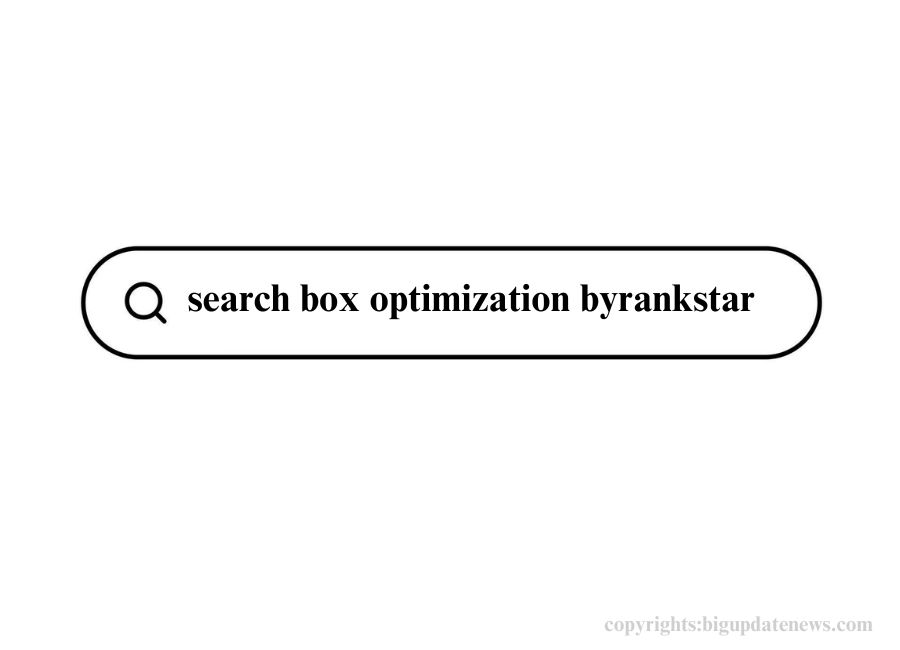In the world of digital spaces, where time is of the essence and information is abundant, a search box is more than just a tool—it’s a gateway. For businesses and websites, this gateway can be the difference between a fleeting visit and a satisfied customer. With search box optimization byRankStar, you can enhance your users’ experience, turning what might be a moment of confusion into a seamless interaction. This post will guide you through the importance of optimizing search functionality and provide actionable strategies for doing so effectively.
Why Search Box Optimization Matters
As the world moves faster, and everything is available online, users want it and they want it now. This simple element can make a huge difference by improving the experience of users that interact with a site and, thus, extending time spent on the site and the rate of conversions. When users can’t find what they’re looking for quickly, they are likely to leave, taking potential business with them. By optimizing your search box, you ensure that users can effortlessly find the information or products they seek, which boosts satisfaction and promotes loyalty.

One of the core benefits of search box optimization is improved user engagement. Websites that provide accurate search results encourage users to explore further. This deeper engagement often translates into higher conversion rates, as users discover more of what your site has to offer. Additionally, understanding user search behavior can unveil valuable insights, enabling you to tailor content to better meet your audience’s needs.
A seamless search experience also strengthens brand credibility. When users consistently find relevant and precise results, it builds trust. This trust encourages repeat visits and establishes your site as a reliable source of information or products. In contrast, poor search functionality can frustrate users and negatively impact your brand’s reputation.
Enhancing User Experience with search box optimization byrankstar
Creating an optimal search box experience begins with understanding what users need. ByRankStar’s approach focuses on making the search process intuitive and efficient. It starts with the design—ensuring the search box is easily identifiable and accessible across all devices. A conspicuous search box invites users to interact with it from the get-go.
Another critical aspect is functionality. The search box optimization byrankstar should accommodate common user behaviors, like handling spelling errors gracefully or suggesting popular queries. By providing users with smart suggestions as they type, you guide them towards relevant content, enhancing their overall experience. This predictive capability also helps users discover new content they might not have initially considered.
Speed is another vital factor. A search box that delivers rapid results keeps users engaged. Delays can frustrate users, leading them to abandon their search or even your site. Therefore, optimizing the performance of your search function is crucial in keeping users satisfied and engaged.
Designing a User-Friendly Search Interface
Hence, usability of your search interface attracts more user interactions than any other aspect of your website’s design. The simplest look works best, especially if the window’s purpose is to clean the space with its interiors’ view. ByRankStar recommends a search box that seamlessly integrates into your site’s overall aesthetic while remaining prominent enough to be noticed immediately.

Consider the placement of your search box. Typically, the top right corner of a webpage is a conventional spot, as users intuitively look there. However, depending on your website’s layout, you might find a central positioning more effective. The key is to ensure that wherever it is placed, it doesn’t compete with other elements for attention.
It is as well important to focus on the size of the search box. It should be large enough for users to see the text they are typing without strain. This is particularly important for mobile users, who often have to deal with smaller screens. Ensuring the search box is responsive and adapts to different screen sizes will provide a consistent user experience across all devices.
Leveraging Predictive Typing and Autocomplete
Predictive typing and autocomplete features are powerful tools in search box optimization byrankstar. These features help users formulate their searches by suggesting likely queries based on just a few letters. This not only speeds up the search process but also reduces the likelihood of user error.
ByRankStar emphasizes the importance of using data-driven insights to power these predictive features. Analyzing past search queries can help you understand common patterns and anticipate user needs. This data can then inform the suggestions your search box provides, making them more relevant and useful.
Autocomplete can also promote lesser-known products or content by suggesting them to users who might not be aware of their existence. By highlighting these options, you can increase visibility for items that might otherwise be overlooked.
Improving Search Relevance and Accuracy
Relevance is at the heart of effective search functionality. Users expect the search results to closely match their queries, and any disparity can lead to frustration. ByRankStar focuses on refining the algorithms that determine search relevance, ensuring users receive the most pertinent results.
To improve relevance, it’s essential to understand the context of user queries. This involves analyzing the intent behind search terms and tailoring results accordingly. Machine learning tools can be used to continuously refine and improve this contextual understanding, adapting to changing user behaviors over time.

Another key strategy is to enable filters and sorting options. Allowing users to refine their search results by categories—such as date, price, or popularity—empowers them to find what they need more quickly and efficiently. This personalization enhances user satisfaction and increases the likelihood of a successful search.
Utilizing Analytics for Continuous Improvement
Analytics are invaluable in the pursuit of perfect search functionality. By tracking search queries, click-through rates, and user behavior, you gain insights into what works and what doesn’t. This data can then inform ongoing adjustments and improvements to your search box optimization byRankStar.
Regularly reviewing analytics can reveal patterns, such as frequently misspelled terms or popular search times. Armed with this information, you can make informed decisions about how to enhance your search capabilities. This might involve updating your predictive typing algorithms or adjusting the design of your search interface.
Additionally, analytics can highlight gaps in your content or product offerings. If users are frequently searching for something you don’t provide, it could indicate an opportunity for expansion. By staying alert to these trends, you can better meet user needs and grow your business.
Engaging Users with Personalized Search Experiences
Personalization is a powerful tool in capturing user interest and enhancing their experience. By offering personalized search recommendations based on previous interactions, you make the user feel valued and understood. ByRankStar suggests leveraging user data to create these tailored experiences.
Personalization can involve recommending similar products based on browsing history or even suggesting content that aligns with the user’s past interests. This not only improves the search experience but also increases engagement by keeping users on your site longer.
It’s important to balance personalization with privacy, ensuring users feel secure in sharing their data. Providing transparent explanations of how their data is used and offering easy options to adjust privacy settings can build trust and encourage continued engagement.
Discover the Power of Voice Search
Voice search is rapidly becoming a staple feature of modern search functionality. With the rise of smart assistants and mobile usage, optimizing your search box for voice queries is crucial. ByRankStar advocates for integrating voice recognition technologies to cater to this growing trend.

Voice search differs from traditional text search in that it often involves more conversational language. Understanding these nuances and adapting your search algorithms accordingly can improve the relevance and accuracy of voice search results.
Additionally, offering voice search can improve accessibility, making your site more usable for those with disabilities or those who simply prefer speaking to typing. This inclusivity can broaden your audience and enhance your brand’s reputation.
Addressing Common Search Box Pitfalls
Despite its importance, the search box optimization byrankstar is often overlooked in web design. By understanding common pitfalls and how to avoid them, you can create a search functionality that truly serves your users. ByRankStar identifies several pitfalls, including neglecting mobile optimization and failing to update search algorithms regularly.
A search box that doesn’t cater to mobile users can alienate a significant portion of your audience. Ensuring that your search interface is responsive and functions seamlessly across devices is essential in today’s mobile-first world.
Regular updates to your search algorithms are also vital. User behavior and language evolve, and your search functionality must evolve with them. Stagnant algorithms can lead to irrelevant results and user frustration, underscoring the need for continuous improvement.
Exploring Innovative search box optimization byrankstar Features
Innovation in search box design can set your site apart from competitors. ByRankStar encourages exploring features such as image search and advanced filtering options to enhance user interaction. These innovative features can provide a richer, more engaging search experience.
Image search, for instance, allows users to search using images rather than text. This can be particularly useful for e-commerce sites, where users might want to find similar products to something they already own.
Advanced filtering options empower users to tailor their search results according to specific criteria. By offering these additional layers of personalization and control, you enhance user satisfaction and promote deeper engagement.
Conclusion
Search box optimization byRankStar is a crucial element of modern web design, transforming user interactions and driving engagement. By understanding user needs, leveraging predictive technologies, and continuously refining your search functionality, you can create an exceptional user experience. The strategies outlined in this post offer a roadmap to optimizing your search box, ensuring that it serves as an effective gateway to your site’s content or products.
For businesses and websites looking to harness the power of search box optimization byRankStar, this post provides valuable insights and actionable steps to start the process. Remember, a well-optimized search box is more than a convenience—it’s an opportunity to enhance user satisfaction, boost conversions, and establish your brand as a trusted source. For more information and expert guidance, consider exploring further resources or consulting with professionals in the field.




